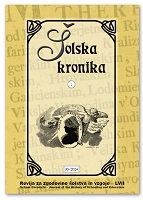Slovenski jezik v prevodu Splošnega šolskega reda s poudarkom na oblikovanju slovenske pedagoške terminologije
Slovenian Language in the Translation of the General School Ordinance, with an Emphasis on the Development of Slovenian Pedagogical Terminology
Author(s): Andreja Legan RavnikarSubject(s): Language studies, Education, Syntax, School education, Philology, Pedagogy
Published by: Slovenski šolski muzej
Keywords: school ordinance; Slovenian language for special purposes; pedagogical (school) terminology; term formation; German syntax;
Summary/Abstract: In December 1774, the first primary education law in the Habsburg hereditary lands, the Allgemeine Schulordnung für die deutschen Normal-, Haupt- und Trivialschulen in sammtlichen Kaiserl-Königl. Erbländern, translated into modern Slovenian as Splošni šolski red (General School Ordinance), was adopted. The legal basis for the establishment of trivial, main and normal schools, thus legalising universal primary education, was translated into Slovenian no later than 1777. Linguistic analysis at the phonological and morphological levels has shown that the text was translated into the Carniolan literary language, as written by Ljubljana writers in the second half of the 18th century in particular. However, the relationship between the phonological form and the spelling in the translation of the General School Ordinance only partly corresponds to the two-hundred-year-old literary tradition. A contrastive analysis of the German-Slovenian legal text with its 24 articles reveals different processes of Slovenisation of terminology. The earliest Slovenian pedagogical terminology was formed to a lesser extent by terminologising already known words from the general language and of Slavic origin (e.g. vučiti, vuk, etc.) and by adopting terms from the German language (earlier adoptions, e.g. šola, šolar, etc., words adopted in the 18th century, e.g. metoda, tabela). Most often, the terminological pool was expanded by loan translations of German compounds. The Slovenian equivalents were less often phrases (e.g. trivialšola), and most often terminological phrases with agreeing premodifiers (e.g. . šolna kamera/ kamra, poglavitna šola 'main school', naturni vuk 'natural science') and rarely terminological phrases with nonagreeing postmodifiers (katalog te pridnosti 'catalogue of behaviour'. A more compelling reason why the translation is difficult to understand for a modern Slovenian reader is the syntax, within which we can identify features of the German language system (loan translations of prepositional phrases, German word order). For the history of Slovenian language, the General School Ordinance is important as an example of an early and long Slovenian official text in print, one of the earliest proofs of the existence of a functional style development of the Slovenian language and the formation of the earliest Slovenian pedagogical terminology.
Journal: Šolska kronika: revija za zgodovino šolstva in vzgoje
- Issue Year: 33/2024
- Issue No: 1
- Page Range: 104-125
- Page Count: 22
- Language: Slovenian

